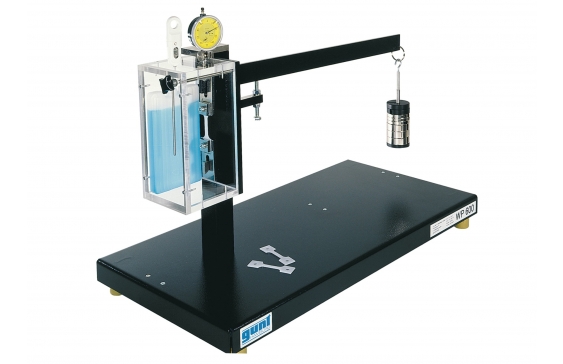WP 600 Creep rupture test

Components that are subjected to long-term constant loads deform plastically. This material behaviour is called creep. The creep rupture test is a destructive test method for determining the material behaviour (creep) at constant test temperature (room temperature and below) and after prolonged exposure to a constant load.
The WP 600 experimental unit demonstrates typical phenomena such as phases of different creep rates or temperature-dependent creep behaviour. The clean layout and simple operation mean the experimental sequence can be observed in all details and phases. Lead and plastic specimens are used in order to achieve acceptable creep rates at room temperature.
Experiments can also be conducted below room temperature by means of a transparent temperature-controlled box with storage elements.
In the experiment, the specimen is subjected to a constant tensile load at a given, constant temperature. The tensile load is generated by a lever and stepped weights. The specimen holders are equipped with knife-edge bearings to avoid bending stresses on the specimen. An adjustable stop protects the dial gauge at fracture of the specimen and prevents the loads impacting the experimental unit.
The elongation of the specimen over time is recorded by a dial gauge and a stopwatch and represented in a strain–time diagram as the so-called creep curve.
- typical phenomena of creep processes
- experiments at or below room temperature are possible
Specimens
- LxW: 25x5mm, thickness 2mm
- 10x lead
- 10x plastic (PE)
Weights
- 1x 1N (hanger)
- 2x 5N
- 3x 2N
- 3x 1N
- 2x 0,5N
Measuring ranges
- tension: 5…25N/mm2
- travel: 0…10mm, graduation: 0,01mm
- temperature: -50…300°C
- investigation of creep behaviour of different materials in creep rupture test
- constant load on the specimen via lever arm and stepped weights
- flat lead and plastic (PE) specimens
- experiments at or below room temperature are possible
- transparent temperature-controlled box with storage elements for cooling the specimen
- dial gauge for determining the elongation
- stopwatch to record time
- creep in specimens of various materials
- record a strain–time diagram (creep curve)
- influence of temperature and load on the creep
- load and recovery in plastics
